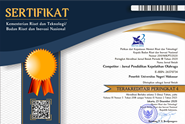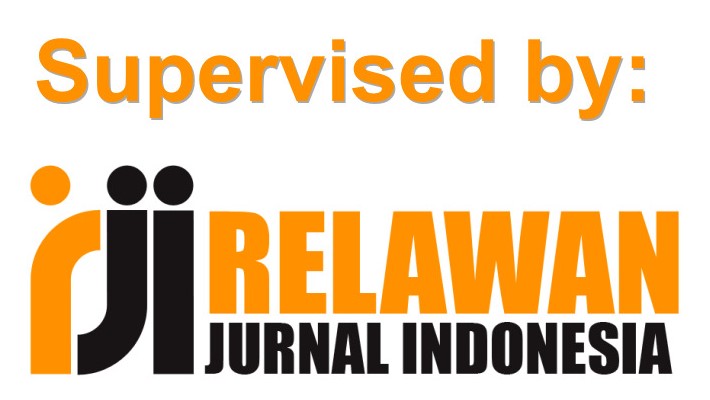Futsal As a Means of Improving Women Football Players' Playing Skills : A Qualitative Assessment of Player Perceptions
(1) Universitas Pendidikan Indonesia
(2) Universitas Pendidikan Indonesia
(3) Universitas Pendidikan Indonesia
(*) Corresponding Author
DOI: https://doi.org/10.26858/cjpko.v13i3.23128
Abstract
Keywords
Full Text:
PDFReferences
Barbero-Alvarez, J., Subiela, J., Granda-Vera, J., Castagna, C., Gomez, M., & Del Coso, J. (2015). Aerobic fitness and performance in elite female futsal players. Biology of Sport, 32(4), 339–344. https://doi.org/10.5604/20831862.1189200
Barron, D. J., Collins, D., & Carling, C. (2020). Match performance in a reference futsal team during an international tournament - implications for talent development in soccer Christopher Yiannaki. Biology of Sport, 37(2), 147–156. https://doi.org/10.5114/BIOLSPORT.2020.93040
Bloomfield, J. R. (2005). Soccer: physical characteristics, physical demands of match-play and effective physical conditioning. In Sport and Exercise Science.
Bush, M., Barnes, C., Archer, D. T., Hogg, B., & Bradley, P. S. (2015). Evolution of match performance parameters for various playing positions in the English Premier League. Human Movement Science, 39, 1–11. https://doi.org/10.1016/j.humov.2014.10.003
Coyle, D., & Farrell, J. (2009). The talent code. Vasa, 1–6. http://medcontent.metapress.com/index/A65RM03P4874243N.pdf%5Cnhttp://www.bottomlinebookclub.com/downloads/TalentCode/bl_on_talentcode_workbook.pdf
Davids, K., Araújo, D., Correia, V., & Vilar, L. (2013). How Small-Sided and Conditioned Games Enhance Acquisition of Movement and Decision-Making Skills. Exercise and Sport Sciences Reviews, 41(3), 154–161. https://doi.org/10.1097/JES.0b013e318292f3ec
Davids, K. W., Button, C., & Bennett, S. J. (2008). Dynamics of Skill Acquisition: A Constraints‑led. Human Kinetics, March, 1–27. https://www.researchgate.net/publication/27476815_Dynamics_of_skill_acquisition_A_constraints-led_approach
Dellal, A., Chamari, K., Owen, A. L., Wong, D. P., Lago-Penas, C., & Hill-Haas, S. (2011). Influence of technical instructions on the physiological and physical demands of small-sided soccer games. European Journal of Sport Science, 11(5), 341–346. https://doi.org/10.1080/17461391.2010.521584
Edwards, E. (2018). Migration and Laws of Contagion: Cultivating Talent in Japanese Women’s Soccer. Japanese Studies, 38(1), 39–56. https://doi.org/10.1080/10371397.2018.1442678
Edwards, E. S., & Sackett, S. C. (2016). Psychosocial Variables Related to Why Women are Less Active than Men and Related Health Implications. Clinical Medicine Insights: Women’s Health, 9s1, CMWH.S34668. https://doi.org/10.4137/CMWH.S34668
FA Futsal. (2013). Benefits of futsal. http://www.thefa.com/-/media/files/pdf/get-into-football/small-sided-football/fa-futsal-benefits-guidance-resource.ashx
FIFA.com. (2019). REGULATIONS FIFA Women’s World Cup France 2019TM. https://resources.fifa.com/image/upload/fifa-women-s-world-cup-france-2019tm-regulations.pdf?cloudid=ztloydigvm0hzcoqbtez
FIFA. (2012). Women’s Football. http://www.fifa.com/mm/%0Adocument/footballdevelopment/women/01/59/58/21/wf_backgroundpaper_%0A200112.pdf;
Gargelli, S. (2020). The Secret To Create The Football Player 3.0. Futsal Solutions. https://futsal.solutions
Hill-Haas, S. V., Coutts, A. J., Dawson, B. T., & Rowsell, G. J. (2010). Time-motion characteristics and physiological responses of small-sided games in elite youth players: The influence of player number and rule changes. Journal of Strength and Conditioning Research, 24(8), 2149–2156. https://doi.org/10.1519/JSC.0b013e3181af5265
Hornig, M., Aust, F., & Güllich, A. (2016). Practice and play in the development of German top-level professional football players. European Journal of Sport Science. https://doi.org/10.1080/17461391.2014.982204
Khaldi, H. M. A. –. (2015). Level of Cognitive Output In The Articles Of Football Law Of The Women Football Futsal Female Players In Jordan. Sport Science, 8(Suppl 2), 35–38. https://www.sposci.com/PDFS/BR08S2/SVEE/04 CL 05 AK.pdf
Martínez-Lagunas, V., Niessen, M., & Hartmann, U. (2014). Women’s football: Player characteristics and demands of the game. Journal of Sport and Health Science, 3(4), 258–272. https://doi.org/10.1016/j.jshs.2014.10.001
Meier, H. E., Konjer, M., & Leinwather, M. (2016). The demand for women’s league soccer in Germany. European Sport Management Quarterly. https://doi.org/10.1080/16184742.2015.1109693
Milligan, I., Borrie, A., & Horn, R. (2007). Technical Analysis of Futebol de Salao and Mini-football. FACA Live - The FA Coaches Association, January, 1–11. http://facalive.thefa.com/NR/rdonlyres/7215DB2C-D038-4C5B-B387-01E0FF94F6FB/105112/TechnicalAnalysisofFuteboldeSalaoandMinifootball.pdf
Mills, A., Butt, J., Maynard, I., & Harwood, C. (2012). Identifying factors perceived to influence the development of elite youth football academy players. Journal of Sports Sciences. https://doi.org/10.1080/02640414.2012.710753
Musculus, L., Lobinger, B. H., & Raab, M. (2016). The Development of Elite Youth Soccer Players’ Decision Making: Implications for Age-Related Decision-Making Training From a Simple Heuristic Approach. Research Quarterly for Exercise and Sport, 87(1), 47–48.
Rampinini, E., Impellizzeri, F. M., Castagna, C., Abt, G., Chamari, K., Sassi, A., & Marcora, S. M. (2007). Factors influencing physiological responses to small-sided soccer games. Journal of Sports Sciences, 25(6), 659–666. https://doi.org/10.1080/02640410600811858
Skubala, M. (2018). Five Reasons Why Grassroots Coaches Should Take Their Players Indoors To Play Futsal. http://www.thefa.com/learning/coaching/5-reasons-why-young-players-should-try-futsal-this-winter
Stirling, A. E., & Kerr, G. A. (2014). Initiating and Sustaining Emotional Abuse in the Coach–Athlete Relationship: An Ecological Transactional Model of Vulnerability. Journal of Aggression, Maltreatment & Trauma, 23(2), 116–135. https://doi.org/10.1080/10926771.2014.872747
Terashita, T. (2011). [Qualitative research methodology]. In Nihon Hoshasen Gijutsu Gakkai zasshi (Vol. 67, Issue 4). PT. Remaja Rosdakarya. https://doi.org/10.6009/jjrt.67.413
Travassos, B., Araújo, D., & Davids, K. (2018). Is futsal a donor sport for football?: exploiting complementarity for early diversification in talent development. Science and Medicine in Football, 2(1), 66–70. https://doi.org/10.1080/24733938.2017.1390322
Travassos, B., Araújo, D., Davids, K., Esteves, P. T., & Fernandes, O. (2012). Improving Passing Actions in Team Sports by Developing Interpersonal Interactions between Players. International Journal of Sports Science & Coaching, 7(4), 677–688. https://doi.org/10.1260/1747-9541.7.4.677
van Biemen, T., Koedijker, J., Renden, P. G., & Mann, D. L. (2018). The Effect of Blurred Perceptual Training on the Decision Making of Skilled Football Referees. Frontiers in Psychology, 9. https://doi.org/10.3389/fpsyg.2018.01803
WashingtonYouthSoccer.org. (2019). Benefits of Playing Futsal. https://washingtonyouthsoccer.org/wp-content/uploads/2019/09/Benefits_of_Playing_Futsal-1.pdf
Woodward, K. (2017). Women’s time? Time and temporality in women’s football. Sport in Society. https://doi.org/10.1080/17430437.2016.1158471
Yiannaki, C., Carling, C., & Collins, D. (2018a). Futsal as a potential talent development modality for soccer–a quantitative assessment of high-level soccer coach and player perceptions. Science and Medicine in Football, 2(4), 299–308. https://doi.org/10.1080/24733938.2018.1483079
Yiannaki, C., Carling, C., & Collins, D. (2018b). Could futsal hold the key to developing the next generation of youth soccer players? Science and Medicine in Football, 2(1), 71–74. https://doi.org/10.1080/24733938.2017.1332422
Article Metrics
Abstract view : 336 times | PDF view : 51 timesRefbacks
- There are currently no refbacks.
Copyright (c) 2021 Muhamad Hanif Ramadhan, Mustika Fitri, Dikdik Zafar Sidik

This work is licensed under a Creative Commons Attribution 4.0 International License.
COMPETITOR IS LICENSED BY :
 COMPETITOR is licensed under a Creative Commons Attribution 4.0 International License.
COMPETITOR is licensed under a Creative Commons Attribution 4.0 International License.
COMPETITOR EDITORIAL LOCATION :
![]() Kampus FIK Banta Bantaeng, Jalan Wijaya Kusuma Nomor 14, Rappocini, Makassar, Postal Code 90222
Kampus FIK Banta Bantaeng, Jalan Wijaya Kusuma Nomor 14, Rappocini, Makassar, Postal Code 90222
COMPETITOR IS INDEXED BY















